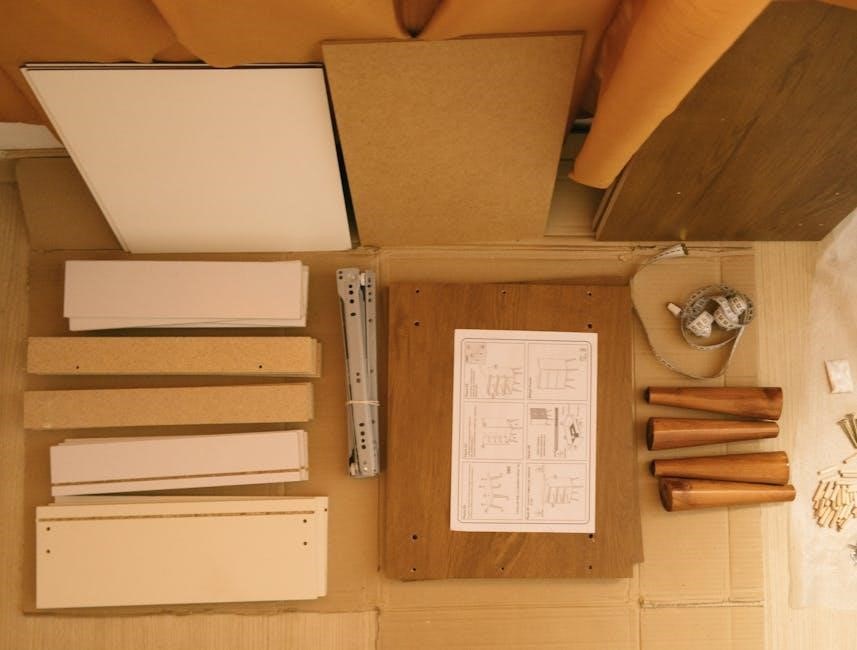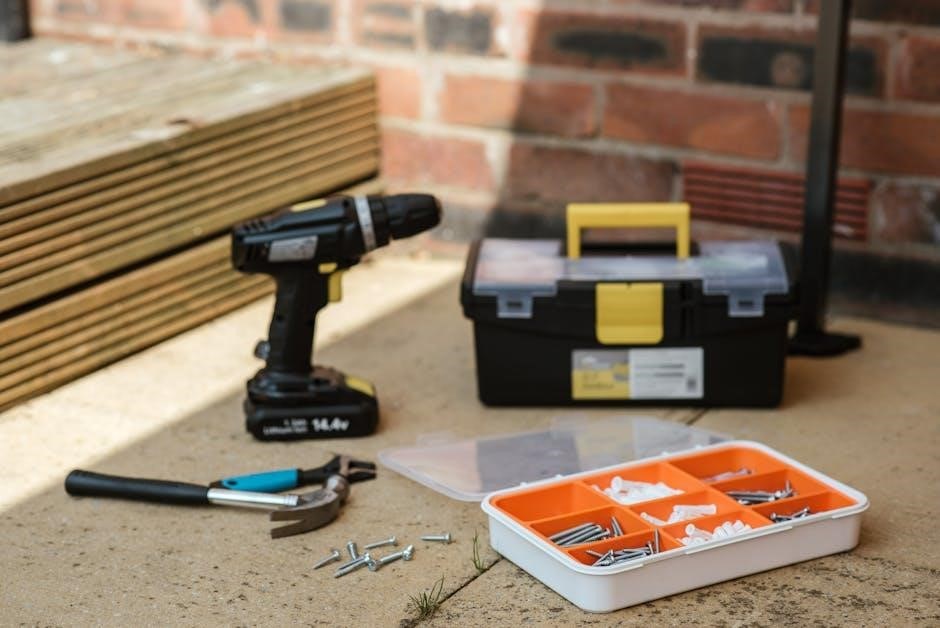Popular among enthusiasts, 2nd Gen Cummins manual swap kits offer a gateway to enhanced performance and driver control. These kits enable transitioning from automatic to manual transmissions, such as the NV4500 or G56, providing improved drivetrain efficiency and tactile driving experiences. While the process is complex, requiring careful planning and specialized components, the end result is a more engaging and capable vehicle tailored for both work and play.

Key Components of a 2nd Gen Cummins Manual Swap
A successful swap requires a manual transmission, clutch kit, wiring harness, driveshaft, crossmember, shifter, and flywheel. These components ensure proper integration and functionality of the manual system.
2.1. Transmission Selection: NV4500 vs. NV5600
Choosing the right transmission is crucial for a 2nd Gen Cummins manual swap. The NV4500 and NV5600 are popular options, each offering distinct advantages. The NV4500, known for its durability and compact design, is ideal for lighter trucks and off-road use due to its shorter gear ratio. It’s also more affordable and easier to install. On the other hand, the NV5600, with its six-speed configuration, provides better fuel efficiency and smoother shifting for heavier vehicles and highway driving. The NV5600’s overdrive gear reduces engine strain at higher speeds, making it a favorite for those prioritizing comfort and efficiency. Both transmissions are robust, but the choice depends on the truck’s intended use and the driver’s preferences.
2.2. Clutch Kit Requirements
A proper clutch kit is essential for a smooth and reliable 2nd Gen Cummins manual swap. The clutch system must be compatible with the chosen transmission and the Cummins engine’s torque output. Heavy-duty clutch kits are recommended to handle the diesel engine’s power, ensuring longevity and performance. Dual-disc clutches are popular for their superior holding capacity, while single-disc setups offer lighter pedal feel. It’s crucial to ensure the clutch aligns with the flywheel and master cylinder for seamless operation. Upgraded components, such as a billet flywheel and a high-performance master cylinder, are often necessary to complement the clutch kit. Proper installation and alignment are vital to avoid premature wear and ensure optimal engagement. Always consult a trusted manual to verify compatibility and specifications for your specific setup.

2.3. Wiring Harness Modifications
Wiring harness modifications are critical when performing a 2nd Gen Cummins manual swap. The primary goal is to adapt the vehicle’s electrical system to recognize and function with the manual transmission. Key modifications include updating the transmission control module (TCM) to eliminate automatic transmission dependencies and integrating a clutch pedal position sensor. The throttle valve (TV) cable must also be recalibrated to ensure proper engine-transmission communication. Additionally, the wiring for the reverse light switch, neutral safety switch, and gear position indicator must be adjusted. For newer models with advanced electronics, custom wiring harnesses or reprogramming may be required. It’s essential to consult a qualified technician or use a pre-engineered wiring harness kit to avoid electrical system malfunctions. Proper wiring ensures smooth operation and prevents issues like incorrect gear readings or loss of engine control.

2.4. Pedal Assembly Installation
Installing the pedal assembly is a critical step in the 2nd Gen Cummins manual swap. This involves replacing the automatic pedal assembly with a manual clutch pedal setup. The clutch pedal must be properly mounted and aligned to ensure smooth operation. A hydraulic master cylinder is typically installed on the firewall, connected to the clutch pedal via a mechanical linkage. The hydraulic line from the master cylinder must be routed to the transmission bellhousing, where it connects to the slave cylinder. Proper bleeding of the hydraulic system is essential to eliminate air bubbles and ensure consistent clutch engagement. Additionally, the throttle pedal may need to be modified or repositioned to accommodate the new manual pedal configuration. This step requires careful measurement and alignment to maintain proper driver ergonomics and functionality. A well-installed pedal assembly is vital for precise control over the clutch and transmission.
2.5. Driveshaft Upgrades
Upgrading the driveshaft is essential when performing a 2nd Gen Cummins manual swap. The switch from an automatic to a manual transmission often requires a driveshaft that can handle the increased torque and different power delivery characteristics. Stock driveshafts may not be suitable due to length differences or material limitations. A high-strength, heavy-duty driveshaft made from materials like chromoly steel is typically recommended to ensure durability and reliability. Additionally, the driveshaft may need to be rebalanced to accommodate the new transmission and engine setup. Proper alignment and installation are critical to prevent vibrations and premature wear on drivetrain components. Many enthusiasts opt for custom-made driveshafts to ensure precise fitment and optimal performance. Upgrading the driveshaft not only enhances the swap’s reliability but also improves the overall driving experience by delivering power more efficiently to the wheels.
2.6. Crossmember and Mounting Solutions
When performing a 2nd Gen Cummins manual swap, the crossmember and mounting solutions are critical for ensuring proper transmission alignment and structural integrity. The stock crossmember is typically designed for the automatic transmission and may not accommodate the manual transmission’s larger size or different mounting points. Aftermarket crossmembers are often necessary to provide the correct fitment and support for the new manual transmission, such as the NV4500 or NV5600. These crossmembers are usually fabricated from heavy-duty materials like steel to withstand the increased stress and torque associated with manual transmissions. Additionally, adjustable transmission mounts may be required to achieve proper drivetrain alignment. Improper installation of the crossmember or mounts can lead to vibrations, misalignment, and premature wear on drivetrain components. It is essential to select a crossmember and mounting kit specifically designed for the 2nd Gen Cummins manual swap to ensure a secure and reliable installation.
2.7. Shifter and Linkage Setup
Setting up the shifter and linkage is crucial for smooth gear engagement in a 2nd Gen Cummins manual swap. The shifter must be installed inside the cabin, often requiring floor pan modifications for proper placement. Ensuring the shifter is comfortably accessible and doesn’t interfere with other controls is essential. The linkage connects the shifter to the transmission, involving universal joints and rods that need precise alignment to prevent shifting issues. Adjustable rods may be necessary for fine-tuning, and custom components might be required for compatibility. Choosing a shifter with the right throw length and feel can enhance the driving experience. Electrical connections may be needed for features like reverse lights. Proper mounting and alignment are vital for durability and smooth operation, ensuring a comfortable and precise shifting experience.
2.8. Flywheel and Master Cylinder Compatibility
Flywheel and master cylinder compatibility are critical for a seamless 2nd Gen Cummins manual swap. The flywheel must be compatible with the new manual transmission, often requiring replacement to ensure proper clutch engagement. A heavier flywheel may be recommended for improved performance and smoother operation. The master cylinder must also be compatible with the manual setup, as the existing unit may not provide adequate hydraulic pressure. Installing a manual-specific master cylinder ensures proper fluid transfer to the slave cylinder. Additionally, a residual pressure valve may be needed to maintain consistent pressure in the clutch system. Proper installation and alignment of these components are essential to avoid clutch slippage or engagement issues. Compatibility ensures optimal performance, making the swap both functional and reliable; Always verify specifications to guarantee seamless integration with your manual transmission setup.

Factors to Consider Before Starting the Swap
Before starting a 2nd Gen Cummins manual swap, consider the cost, vehicle compatibility, and build difficulty. Assess your mechanical skills and time commitment. Ensure all components are compatible. Plan for potential risks and setbacks. Research thoroughly to avoid costly mistakes.
3.1. Build Difficulty and Time Commitment
Performing a 2nd Gen Cummins manual swap is a challenging project that requires significant mechanical aptitude and time. Enthusiasts should expect the process to take several weeks, depending on experience and workload. The complexity involves not only swapping the transmission but also modifying wiring, installing a clutch pedal, and upgrading drivetrain components. Novice builders may face steep learning curves, while experienced mechanics can still encounter unexpected issues. Proper planning and preparation are critical to avoid delays. Additionally, sourcing the right parts and tools can extend the timeline. It’s essential to allocate ample time for research, fabrication, and troubleshooting. For those new to such projects, seeking guidance from forums or experienced builders is highly recommended. Ultimately, patience and dedication are key to a successful swap.
3.2. Cost Estimates for the Swap
The cost of a 2nd Gen Cummins manual swap can vary widely, depending on the components chosen and the extent of the modifications. On average, enthusiasts can expect to spend between $5,000 and $10,000 or more for a complete swap. The transmission itself, such as an NV4500 or NV5600, can range from $2,000 to $4,000, depending on its condition and source. Additional costs include a clutch kit ($500–$1,000), wiring harness modifications ($300–$800), and drivetrain upgrades like a heavy-duty driveshaft ($500–$1,000). Pedal assemblies, crossmembers, and shifter setups add another $1,000–$2,000. Labor costs, if hiring a professional, can double the total expense. Budget-conscious builders often opt for used or refurbished parts, while others prefer new components for reliability. Properly planning and sourcing parts can help manage costs, but unexpected expenses are common in such complex projects.
3.3. Vehicle Compatibility and Year Considerations
Vehicle compatibility and year considerations are critical when planning a 2nd Gen Cummins manual swap. The swap is most straightforward for 98.5-02 Ram 2500 and 3500 models, as these trucks were originally equipped with the 24-valve 5.9L Cummins engine and compatible drivetrain components. Later model years, such as 2003 and beyond, may require additional modifications due to differences in engine electronics and emissions systems. Enthusiasts attempting the swap on non-2nd Gen platforms often face increased complexity and custom fabrication needs. It’s essential to verify the compatibility of the transmission, engine, and drivetrain components before starting the project. Additionally, consulting with experienced builders or forums can provide valuable insights into year-specific challenges and solutions. Proper research ensures a smoother transition and avoids costly missteps during the swap process.
Common Mistakes to Avoid During the Swap
One of the most common mistakes during a 2nd Gen Cummins manual swap is insufficient planning and research. Many enthusiasts underestimate the complexity of the process, leading to unexpected delays and costs. Another error is incorrectly selecting the transmission, such as choosing the wrong NV series model, which can result in compatibility issues. Improper installation of the wiring harness and pedal assembly is also a frequent oversight, often causing electrical malfunctions. Additionally, neglecting to upgrade the driveshaft or crossmember can lead to mechanical failure under stress. Using the wrong clutch kit or flywheel can result in poor engagement and premature wear. Rushing the installation without proper alignment or testing is another mistake that can lead to long-term reliability problems. Lastly, failing to consult experienced builders or forums can leave enthusiasts unprepared for year-specific challenges, emphasizing the importance of thorough preparation and guidance.